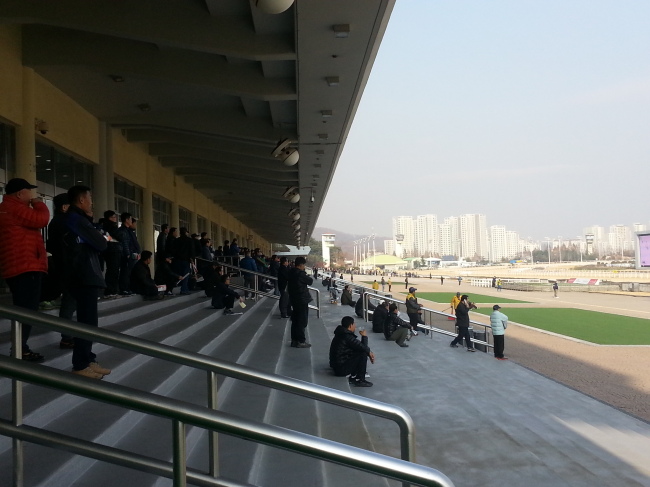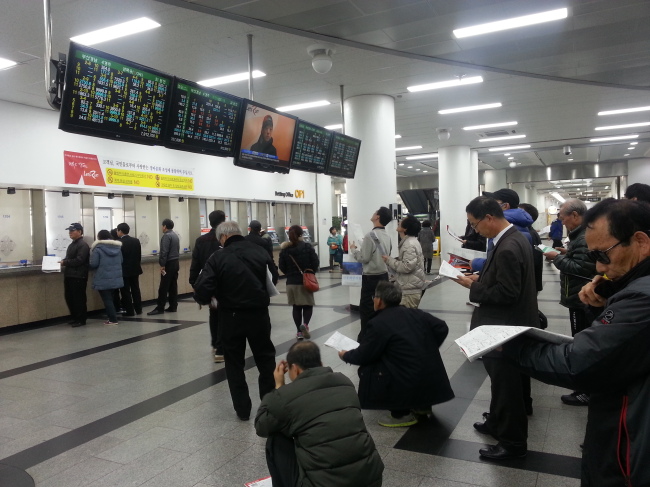업계 관계자는 이 건물들을 “경마 판 설국열차”라고 불렀다. 두 동 모두 1층부터 6층까지 이루어져 있고, 1층부터 저층은 주로 일반인들이 사용한다고 한다. 위층으로 갈수록 더욱 다양한 서비스를 이용할 수 있으며, 5층, 6층에는 마주 등 VIP들이 사용하는 시설이 위치하고 있다. 특히, 6층에는 뷔페 시설 등 프리미엄 서비스를 즐기면서 경마를 관람할 수 있다.
경마는 합법적이긴 하지만, 본질적으로는 도박이기 때문에 부작용이 발생할 수 밖에 없다. 카지노나 다른 도박과 마찬가지로 한번 빠지면 헤어나오기 어렵다. 문화관광연구원 조사 결과에 따르면 화상 경마장의 도박 중독률은 73퍼센트에 달하고, 경마장에서 직접 경마를 하는 사람들의 중독률은 40퍼센트에 이른다고 한다.
이러한 경마의 부작용과 부정적인 여론 때문에 마사회는 현재 국내 여러 지역에서 화상경마장 확장사업과 관련해 주민 및 지자체와 마찰을 빚고 있다. 최근에는 용산구 내 화상경마장 개장과 관련해 서울시와 용산주민과 갈등을 빚고 있다. 박원순 서울 시장은 최근 용산 경마장에 대해 “만약 권한이 있다면 화상 경마장을 진작 폐쇄했을 것,”이라는 강경 발언을 했다.
사행성 도박이라는 이미지와 도박 중독 등의 많은 문제점을 안고 있는 경마공원, 대중의 인식을 바꾸고 가족공원으로의 탈바꿈을 하기 위해서는 갈 길이 아직 멀어 보인다.
<관련 영문 기사>
Horse racing agency fails to shed stigmaRacecourse park has class structure of its own
The Korea Racing Authority, South Korea’s public agency to promote horse racing, has long been trying to change the negative public perceptions on the horse racing industry and to make horse race parks across the nation family-friendly places.
The scene at Seoul Racecourse Park in Gwacheon City, however, showed that these efforts have yet to bear any fruit.
“It will be next to impossible to improve the park‘s environment,” said a former employee of KRA who described the park as nothing short of a gambling den.
When the races open, those who come to bet on the horses -- mostly men in their 50s or older -- are glued to the TV screens inside the two six-story grandstand buildings or to the big screens in the arena.
But the bigger problem is the huge gap that exists between the VIPs and those who come to bet with pocket money. The divide is such that some have compared the park to the bullet train featured in the movie Snowpiercer where the elites inhabit the front of the train while the underprivileged residents inhabit the tail.
The only difference in the racecourse park buildings—one is called the Lucky Ville and the other Happy Ville-- is that the class system is formed vertically, not horizontally.
The VIPs including the horse owners can watch the races on the top of the buildings, enjoying premium services including customized catering services while the underprivileged betters stay on the lower floors, eating hot dogs and other cheap snacks.
Once all the scheduled races come to a close at the end of the day, betting tickets, horse racing magazines and food wrappers are found rolling around on the floors of the grandstand buildings amid a sense of dispair.
High addiction rates is another reason for the negative sentiment toward the horse racing industry. Recent research showed that the addiction rate among those betting on horseraces located further away from metropolitan areas stood at 80 percent. The rate for those betting at the arenas in Gwacheon, Busan and Jeju, stood at 43 percent, according to the data.
Due to the high addiction rates, the KRA’s plans to expand into more betting facilities across the nation has been met with much flak.
Recently, the KRA clashed with residents in Yongsan-gu in Seoul City where it is trying to launch a betting facility.
Siding with the opponents to the plan, Seoul mayor Park Won-soon criticized the public agency, saying that the plan to build the gambling place in a residential area is “inappropriate,“ adding that he would have “abolished the plans” if he had the authority to do so.
The KRA‘s goal to make horse racing into a healthy, popular sport by transforming the racing parks into family-friendly venues for fun and leisure seems to be still a long way off.
By Kim Young-won (
wone0102@heraldcorp.com)






![[Exclusive] Hyundai Mobis eyes closer ties with BYD](http://res.heraldm.com/phpwas/restmb_idxmake.php?idx=644&simg=/content/image/2024/11/25/20241125050044_0.jpg)
![[Herald Review] 'Gangnam B-Side' combines social realism with masterful suspense, performance](http://res.heraldm.com/phpwas/restmb_idxmake.php?idx=644&simg=/content/image/2024/11/25/20241125050072_0.jpg)

